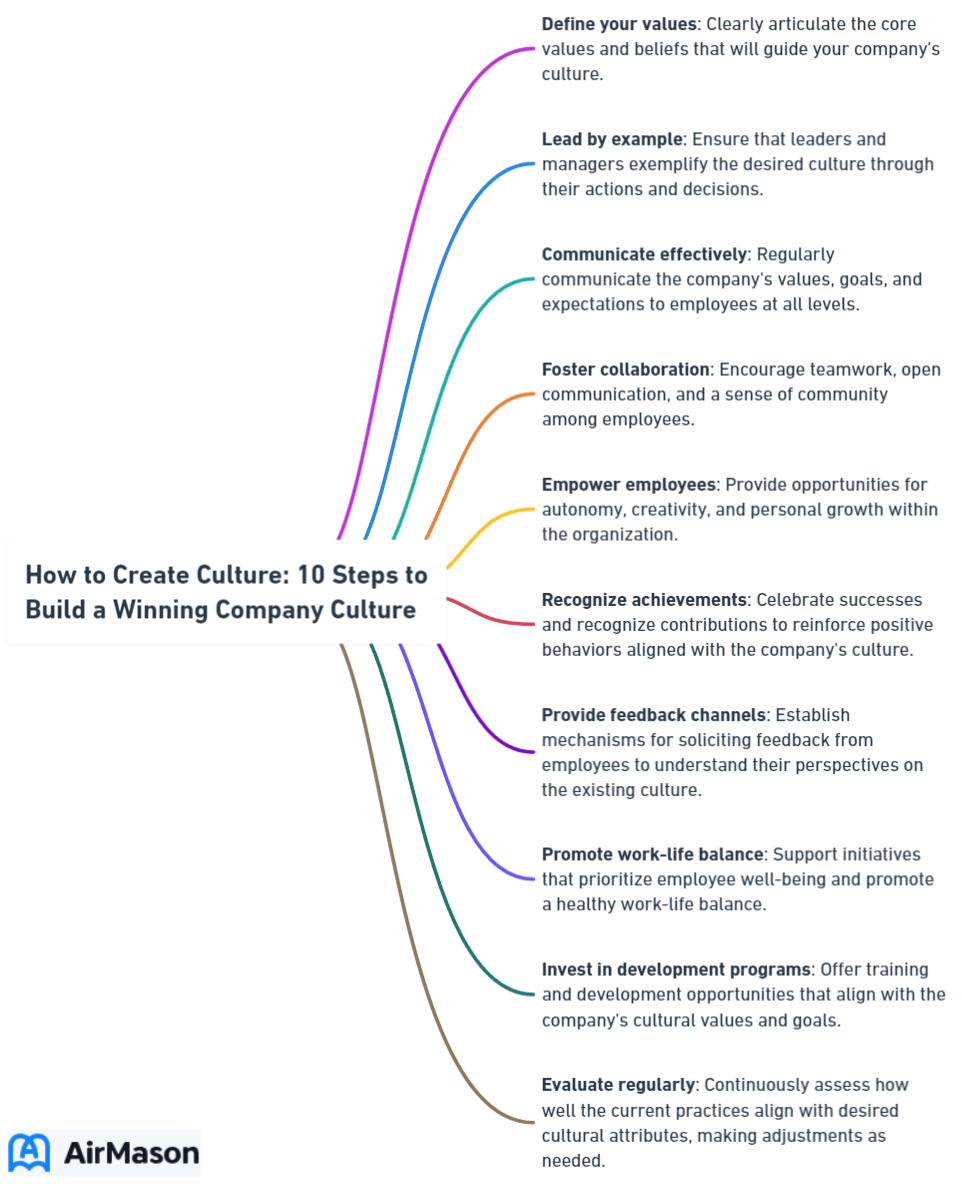
Creating a winning company culture is essential for business growth, employee satisfaction, and long-term success. But how do you build a strong culture that fosters innovation, collaboration, and a positive work environment? In this blog post, you’ll discover a 10-step process on how to create culture that will help you create a thriving company culture in 2024 and beyond.
Key Takeaways
- Create a winning company culture in 2024 by understanding the importance of core values, fostering inclusivity and diversity, encouraging open communication & prioritizing employee well-being.
- Develop effective leadership and implement recognition/rewards programs to motivate employees for success.
- Monitor & adjust culture with feedback to create an adaptable work environment that benefits everyone.
Understanding the Importance of Company Culture
A great company culture is more than just having a cool office or fun perks. It’s about creating an environment where your team members feel valued, engaged, and inspired to do their best work. A strong company culture sets the foundation for a healthy work environment and encourages employee engagement, ultimately driving business growth. In fact, a toxic corporate culture can be a significant predictor of industry-adjusted attrition, making it ten times more influential than compensation in predicting turnover. Understanding various company cultures and the impact of a company’s culture can help organizations identify the best practices to adopt and foster a good company culture, ensuring a positive work environment.
What then are the steps to cultivate a robust company culture? One of the first steps is to be selective when hiring. Work style and volume expectations are key components of company culture. The atmosphere could be more laid-back or high-performance, and there could be flexibility in where and when team members work. Communication style and culture also play a crucial role in shaping the company culture. Experts recommend focusing on the intangibles and non-monetary benefits that will make your company an attractive opportunity.
Investing time and effort into cultivating a robust company culture undeniably yields significant benefits. A positive work atmosphere attracts top talent and improves overall performance. Increased productivity and efficiency are the key benefits of improved employee engagement. Moreover, it can lead to improved job satisfaction, lower stress levels, and greater employee morale. A strong company culture can even give your organization a competitive edge in the market, making it more attractive to top talent, customers, and partners.
The organization’s values and mission statement form the core of a vibrant company culture. These company’s values define the company’s identity and expectations, shaping employee behavior and decision-making processes. By understanding and promoting these values, you can create a healthy company culture where employees thrive, work-life balance is respected, and everyone feels aligned with the company’s mission and vision.
Identifying Your Company’s Core Values
The foundation for a robust corporate culture lies in the establishment and consistent upholding of your company’s core values. These values should guide how employees interact with one another, how they can expect to be treated, and what values everyone in the company holds in common. Identifying your company’s core values is crucial for setting the tone for your organizational culture and ensuring alignment with your mission and vision.
Decision-making norms play an important role in fostering a positive workplace culture by guiding how decisions are made within a company. When employees understand these norms and how they align with the company’s values, it creates a strong foundation for a healthy company culture.
Employees can demonstrate your company’s culture through their actions and interactions with colleagues and customers. For example, our employees have shown what it means to embody our company culture by:
- Sending customer flowers for their 30th wedding anniversary
- Ordering an Uber for a customer’s tenant in need
- Sending prepared meals to co-workers and their families during difficult times
These actions reinforce the company’s values and create a positive work environment where employees feel supported and inspired to do their best work.
Clear communication of your company’s core values to both new and existing employees is a key leadership responsibility. This ensures that everyone is on the same page and understands the expectations and values that guide the organization. When employees know what the company stands for and how their actions contribute to its success, they are more likely to feel engaged, committed, and aligned with the company’s mission.

An Organization’s Culture
An organization’s culture encompasses the shared values, beliefs, and practices that shape its work environment. It serves as the bedrock upon which all operations and interactions are built. This culture defines the way employees collaborate, communicate, and approach their tasks, ultimately influencing the overall performance and success of the organization. An organization’s culture is not static; it evolves over time through the collective experiences and behaviors of its members. It sets the tone for how individuals within the organization interact with one another, as well as with external stakeholders, creating a distinctive identity that distinguishes it from others in the same industry. Therefore, understanding, nurturing, and aligning with an organization’s culture is paramount for individuals and teams to thrive within its dynamic framework.
Assessing the Current State of Your Company Culture

Assessment of the current state of your company culture is a prerequisite for its improvement. Evaluating existing practices, communication styles, and employee satisfaction can help you identify areas for improvement and provide a strong foundation for creating a culture of success.
One way to gauge the success of your company culture is by measuring employee satisfaction, turnover rate, and engagement. Employee surveys can also provide valuable insights by uncovering recurring patterns in responses and pinpointing legitimate areas of concern. By addressing these issues, you can create a healthier company culture and improve employee morale.
Proactively addressing potential issues is crucial in preventing the development of a toxic company culture. For example, if your employee satisfaction index (ESI) indicates that your employees are not happy with their jobs, take action to improve their experience and create a more positive work environment. Recent trends, such as the 47 million workers who chose to take the next step in their career in 2021 and the 4.4 million people who pursued new opportunities in February 2022, highlight the importance of building a strong organizational culture to retain top talent.
Maintaining a positive and engaged work environment where employees thrive requires continuous assessment and necessary adjustments of your company culture. Make sure to prioritize open communication, employee well-being, and diversity and inclusion to ensure your company culture remains strong during periods of growth or stagnation.
Fostering Inclusivity and Diversity

A healthy and thriving company culture is deeply rooted in inclusivity and diversity. A diverse workforce encourages understanding, consideration, and provides a comprehensive experience at work. By fostering diversity and inclusion, you can unlock innovation, make more informed decisions, and increase your chances of achieving your financial goals.
Hiring managers play a vital role in fostering diversity within the organization. Instead of focusing on culture fit, which can be misleading and lead to inaccurate evaluations, hiring managers should:
- Use precise language to assess how potential new hires embody the organization’s values and align with the mission statement
- Ensure more accurate assessments
- Help create a more inclusive and diverse workforce
Fostering a healthy company culture necessitates the promotion of equal opportunities and the creation of an inclusive work environment. Assessing pay equity and offering accessible compensation can help ensure fairness and create a positive working environment for all team members. Additionally, educating hiring managers on unconscious bias and making diversity and inclusion a priority can help create a more inclusive hiring process.
An inclusive and diverse environment nurtures a strong corporate culture, where employees of all backgrounds feel valued, respected, and are empowered to contribute to the company’s success. This inclusive culture not only benefits individual employees but also contributes to the overall success and growth of the organization.
Encouraging Open Communication

Trust, collaboration, and a strong company culture are essential elements to build a strong and successful organization. Open communication channels, regular feedback, and active listening can help create a supportive and engaged work environment where employees feel heard and valued.
Actively seeking employee feedback and suggestions is a method to cultivate open communication within the organization. Instantly sending surveys on any matter and providing a suggestion box for employees to submit their ideas can help you gain valuable insights and make informed decisions for the company.
Fostering trust within a company culture is crucial for open communication. By training management to communicate openly, seeking feedback from all employees, and creating an inclusive environment, you can strengthen trust in the organization and encourage constructive feedback.
Cultivating open communication as a cultural trait within teams fosters a positive work atmosphere, where employees are at ease sharing their thoughts and ideas. This open dialogue not only contributes to a healthy company culture but also helps drive innovation, collaboration, and overall business success.
Prioritizing Employee Well-being

A successful company culture greatly depends on the well-being of its employees. By offering resources and tools for physical and mental health, promoting work-life balance, and creating a supportive environment, you can increase productivity and employee satisfaction.
Some examples of resources and tools that can help employees prioritize their well-being include gym stipends, mental health funds, and fertility benefits. By providing these resources, you demonstrate that your organization is invested in more than just the bottom line and genuinely cares about the well-being of its employees.
Promoting work-life balance and creating a supportive environment are essential for employee well-being. Here are some strategies to achieve this:
- Encourage open communication
- Delegate responsibility judiciously
- Prioritize diversity and inclusion
- Make information readily accessible
By implementing these strategies, you can create an environment where employees feel supported and valued.
Prioritizing employee well-being contributes to the overall success of your organization and fosters a positive work environment. When employees feel cared for and valued, they are more likely to remain engaged, committed, and motivated to contribute to the company’s success.
Developing Effective Leadership
Cultivating a strong company culture is highly dependent on effective leadership. Leaders play a significant role in communicating company values, leading by example, and empowering employees to take ownership of their work. By doing so, they contribute to the organization’s success and create an environment where employees feel supported and inspired.
One example of effective leadership practice is the role of managers at Adobe. These managers act as motivating coaches and empower their employees to set goals and decide how they should be evaluated. This approach fosters a sense of ownership and commitment among employees, ultimately contributing to a strong company culture.
Through their actions and interactions with team members, leaders should manifest their commitment to the company’s values. By embodying the company’s values and mission, leaders can set the tone for the rest of the organization and ensure that these values are consistently upheld.
Developing effective leadership is an ongoing process that requires continuous evaluation and feedback. By regularly assessing leaders’ performance and providing constructive feedback, you can ensure that your organization’s leadership remains strong, adaptable, and aligned with the company’s values and goals.
Cultivating a Culture of Care
A “culture of care” is not merely a buzzword, but a cornerstone of a thriving and empathetic society. It encompasses a collective mindset that prioritizes the well-being and flourishing of every individual, fostering an environment where compassion and support are integral. In a culture of care, acts of kindness are not incidental, but embedded in the fabric of daily interactions. This ethos extends beyond individual relationships to permeate workplaces, institutions, and communities at large. It promotes inclusivity, empathy, and active listening, creating a space where everyone feels valued and heard. Moreover, a culture of care transcends boundaries of age, gender, and background, recognizing the inherent worth of every human being and acknowledging the significance of their experiences. As we embrace and nurture this ethos, we pave the way for a more harmonious and equitable world.
Implementing Employee Recognition and Rewards

Boosting morale, increasing engagement and reinforcing company values are hallmarks of employee recognition and rewards programs. Recognizing and celebrating employee achievements can create a positive and motivating work environment where employees feel valued and inspired to do their best work.
Expressing gratitude to employees for their hard work and accomplishments can enhance employee satisfaction and loyalty. Some simple gestures to show appreciation include:
- Sending a thank you note
- Providing public recognition
- Offering small rewards or incentives
- Organizing team-building activities
- Giving personalized gifts or tokens of appreciation
These gestures can go a long way in making employees feel valued and appreciated.
Implementing effective employee recognition and rewards programs can be achieved through various approaches. Some examples include peer recognition programs, performance-based bonuses, and personalized rewards that align with employees’ interests and preferences.
Recognizing and rewarding employees for their achievements fosters a positive work environment and contributes to the overall success of the organization. Engaged and motivated employees are more likely to attract and retain commitment to the company’s goals, leading to increased productivity, innovation, and growth.
Promoting Continuous Learning and Growth
Maintaining a dynamic and adaptable company culture necessitates promoting continuous learning and growth within the organization. By encouraging skill development, providing learning opportunities, and supporting career growth, you can keep employees engaged and committed to the company’s success.
Continuous learning and growth benefit both employees and the organization.
- Employees can develop new skills
- Expand their knowledge
- Advance their careers
- The organization benefits from a more skilled and adaptable workforce.
Providing learning opportunities can take many forms, such as offering training programs, sponsoring professional development courses, or creating mentorship programs within the organization. By investing in your employees’ growth, you demonstrate your commitment to their success and well-being.
A company culture that promotes continuous learning and growth fosters an environment where employees feel supported, valued, and motivated to contribute to the organization’s success. This commitment to employee development not only benefits individual employees but also contributes to the overall growth and success of the organization.
Monitoring and Adjusting Company Culture
Continuous improvement and long-term success require diligent monitoring and adjusting of the company culture. Regularly evaluating your culture through employee feedback, KPIs, and other metrics can help you identify areas for improvement and ensure alignment with your organization’s goals and values.
Utilizing employee feedback can provide valuable insights into your company culture and help you make informed, strategic decisions to improve employee engagement, ensuring continuous improvement. By addressing identified issues, you can foster a positive and engaged work environment where employees thrive.
Key performance indicators (KPIs) can also help you measure the progress of your company culture and set goals for improvement. By monitoring these metrics, you can make smarter decisions for your organization and ensure your company culture remains strong and aligned with your goals.
By continuously monitoring and adjusting your company culture, you can create a dynamic and adaptable work environment where employees feel supported, valued, and motivated to contribute to the organization’s success. This commitment to ongoing improvement not only benefits individual employees but also contributes to the overall success and growth of the organization.
How to Stay Positive at Work
Maintaining a positive outlook in the workplace is crucial for both productivity and overall well-being. To effectively learn how to stay positive at work, it’s important to start with a proactive mindset. Begin each day by setting achievable goals and visualizing successful outcomes. Additionally, fostering a supportive network of colleagues can significantly contribute to a positive work environment. Embrace challenges as opportunities for growth rather than seeing them as obstacles. Taking short breaks to clear your mind and refocus can also help you stay positive and productive throughout the day. Finally, practicing gratitude by acknowledging your accomplishments, no matter how small, can go a long way in boosting your morale and maintaining a positive attitude at work.
Summary
In conclusion, building a winning company culture in 2024 and beyond requires a comprehensive approach that focuses on understanding the importance of company culture, identifying core values, fostering inclusivity and diversity, encouraging open communication, prioritizing employee well-being, developing effective leadership, implementing employee recognition and rewards, promoting continuous learning and growth, and constantly monitoring and adjusting the culture. By following these ten steps, you can create a thriving company culture that not only benefits individual employees but also contributes to the overall success and growth of your organization.
Frequently Asked Questions
How do you create a strong culture?
Create a strong culture by hiring people who embody the company values, communicating those values to employees, rewarding excellence, creating meetings that inspire and motivate employees, thanking employees for their efforts, setting clear objectives, promoting diversity and inclusion, fostering trust and responsibility amongst all levels of the organization, increasing transparency and clarity to reduce silos, and developing great hiring and onboarding processes.
Can someone create a culture?
Yes, one can create a culture by influencing the group dynamics and their interactions with the outside world. However, they don’t ‘own’ it; rather, it is an emergent property of the group. This means that culture is not something that can be directly controlled or owned by an individual. Instead, it arises from the collective actions and behaviors of the group as a whole. It is shaped by the interactions between group members and their environment. By understanding and influencing these dynamics, it is possible to shape the culture of a group. This can be done through various means, such as promoting certain values and norms, encouraging collaboration and communication, and fostering a positive and inclusive environment. However, it is important to recognize that culture is not static and can evolve over time. It is influenced by external factors and is subject to change. Therefore, creating a culture is an ongoing process that requires continuous effort and adaptation. In conclusion, while it is possible to create a culture by influencing group dynamics, it is important to understand that culture is an emergent property of the group as a whole. It is shaped by the collective actions and behaviors of its members and is subject to change over time.
What are the 3 C’s of company culture?
The 3 C’s of company culture are Communication, Connection and Caring, all of which contribute to employee loyalty and productivity. Consistency and Communication also play a vital role in developing a successful organization.
What are the key components of a strong company culture?
Creating an environment of open communication, clear values, inclusivity and diversity, effective leadership, recognition, rewards, and a focus on employee well-being and growth are all key components of a strong company culture.
How can a company assess its current culture?
Assessing a company’s culture is important to ensure employee satisfaction, and this can be done through feedback, surveys, engagement metrics and tracking turnover rates. Doing so will give an accurate representation of the current workplace atmosphere.